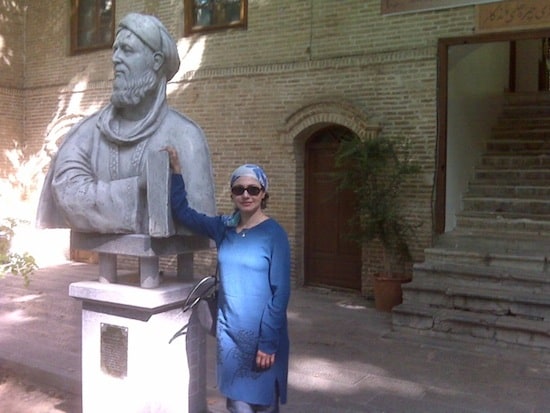Living in Iran: My Experience with the Healthcare System


Lastly, since my father was having his lab work done, I agreed to have my blood drawn. I must confess that remembering the impeccable bedside manners of my pediatrician and general physician when we used to live in Iran years ago made me look forward to my experiences.

The teaching hospital:
No judgment. I was there only to observe. One must take into account the resources available to a third world country under economic sanctions. I stopped at one of the floors to ask for directions and was disheartened to see women patients having to cover their hair in their rooms. It seemed to me that the sick patient had enough to worry about. Apparently, this does not take place in private hospitals.
Before walking into the O.R. I noticed a prayer hanging above the operating room entrance, for the protection of the patients and their physicians. Though not particularly religious, my somewhat spiritual nature makes me appreciate others’ beliefs and religious practices. It reminded me of a surgeon’s discourse with God before each of her surgeries: “These are your hands now. Don’t let me down.”
As a woman, I was not allowed to touch him the way I used to hold my patients’ hands back in the U.S.
Just like our own teaching hospitals, these ones are also short staffed. Where they impressed me the most was how the doctors were treated with the utmost respect both by their patients and by each other.
Both nurses and women physicians had to be covered in green scarf and manteu, provided by the hospital, in the operating room. Here’s where my tolerance gave in: our patient, along with others, sat in a chair in the operating room hallway before walking, not being carried on a gurney or wheelchair, to his procedure room. There was no privacy for him or others who sat next to him. Once he walked into his designated room, no one from the team went inside to comfort him. As a woman, I was not allowed to touch him the way I used to hold my patients’ hands back in the U.S. Only after voicing my concern did the attending physician go inside to comfort him. His residents remained oblivious.
The OBGYN office:
My aunt referred me to her friend for a check up. She also warned me not to expect to be seen exactly on time. I can understand that. Traffic often makes it difficult for people to be on time. Imagine what would happen if one patient were late. It can have a domino effect.
In all fairness I was called at exactly 5:30pm, my appointment time. Her secretary handed me the paperwork and asked for 16,000 tomans. I looked at mom. “Is she serious? That’s 16 dollars!” Mom smiled. Another 16 for the Pap smear. This is all with no insurance. “Wow. Let’s do all of our medical work here.” Having been in the field I have high expectations from the doctors. Patients yearn for that connection, and comfort from their doctor. Unfortunately, my doctor, a woman, a friend of the family even, skipped over that part. She also omitted the small talk, the explanation or the warning and jumped straight to the exam with her instrument.
I almost fell out of the stirrups. She then handed me the specimen jar to take to lab. In an urgent situation, like an infection, when the doctor needs her results immediately, this practice is absolutely acceptable. The doctor may send her patient to the hospital lab to have the results as quickly as possible and initiate her treatment accordingly. But a regular biopsy? She also handed me a prescription, which she should not have, but we will get to that later. I paid one dollar and 70 cents for what would cost around 25 dollars in the U.S.! Unfortunately, lab results later revealed that she had misdiagnosed me.
As for labs, because of no privacy laws, anyone can pick up your results. Just not over the phone.
I paid one dollar and 70 cents for what would cost around 25 dollars in the U.S.! Unfortunately, lab results later revealed that she had misdiagnosed me.
Now let me also tell you a little something about the pharmacies. The few times that I dealt with them, either for my father or for me, I had no prescription and that was quite alright. I wonder if perhaps the fact that the medications I wanted were not controlled substances had something to do with the pharmacist’s lenience. However, antibiotics, antacids, anti-emetics (anti-nausea), and prostate medications were sold to me without a prescription. The pharmacists appeared knowledgeable but also nonchalant. I even called the pharmacy once, ordered my medicines, and had a total stranger, the grocery delivery boy, pick it up without a question.
Here’s my recommendation: if you choose to take advantage of this particular system, tell the pharmacist about your allergies as well as other medications you may be taking to prevent adverse reactions.
Please pardon my ranting. Patient care is near and dear to my heart, and I am not as forgiving about it as I may be about other issues. The day that our patient is no longer a priority, we have entered the commerce of medicine and strayed from our role as a healer. I am not advocating that doctors should not be compensated. They just shouldn’t lose sight of their primary responsibilities.
Happy Travels.
To read more from Bahar, visit baharanooshahr.wordpress.com and follow her @banooshahr.
Living in Iran: My Experience with the Healthcare System, Living in Iran top photo by Unsplash.








